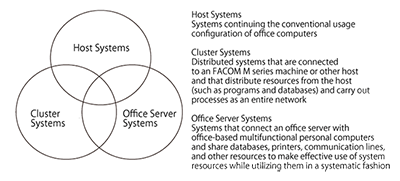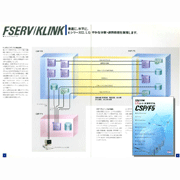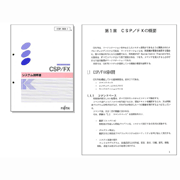CSP (which stood for“Customer-oriented System Products”) was an operating system developed jointly by Fujitsu and USAC Electronic Industrial (which later became PFU) for the FACOM K series of office computers. CSP/F1 and CSP/F3 were announced in May 1984 and CSP/F5 was announced in May 1985. CSP/FX, an operating system that merged CSP/F3 and CSP/F5, was announced in October 1988.
CSP was designed to unify CPS80 (the operating system for the FACOM System 80 series) and UNIOS (the operating system family for the FACOM V series) while ensuring the continuity of past user software assets and connectivity with existing office computers.
The FACOM K series covered a wide array of machines, from the K-10 series of ultra-small machines that suited workstation applications to the K-200 series of large office computers. Similarly, the CSP operating systems’ architectures were scaled to meet various applications and sizes: CSP/F1 was intended for smaller machines, CSP/F3 for medium-sized applications, and CSP/F5 for larger machines.
1. CSP/F1, CSP/F3, and CSP/F5
Table 1 lists the software components of the three operating systems. The most distinctive model in the FACOM K series was the FACOM K-10 (and its subsequent successors), which was equipped with standalone functionality and the functionality to act as a workstation for a host computer. CSP/F1 was the operating system that supported this twin functionality. Fujitsu’s idea behind the FACOM K series was to offer businesses the entry-level FACOM K-10 as an easy way into office computer systems. Then, as the business’s processes and applications grew in size, Fujitsu offered the extensibility to expand to an office computer system in which FACOM K-10s were repurposed as workstations in a distributed processing environment. Fujitsu called this concept “enter small and expand rapidly.” The FSERV protocol for communication functions (file server functions) underpinned the FACOM K series’ extensibility.
Table 1: Software components of CSP/F1, CSP/F3, and CSP/F5
| Applicable machines |
Category |
Sub-category |
Operating system version |
Component function names |
| FACOM K-200 series, K-200R series, and K-300R series |
System programs |
Basic SCP
|
CSP/F5
CSP/F3 |
Workstation control, resource management, confidentiality protection, data management, job management, spooling, auto-operation |
| Database |
CSP/F5
CPS/F3 |
RDM(*1) |
| Communication functions |
CSP/F5
CSP/F3
|
FSERV(*2),KLINK(*3) |
| Other utilities |
CSP/F5 |
CL(*4),CG,file management utility |
| CSP/F3 |
JCL,CG,file management utility |
| Network programs |
Manual protocols |
CSP/F5
CSP/F3 |
HDLC, SDLC, BSC, Japanese Bankers Association, JCA, DT 9611, CAFIS |
| Workstation emulation |
CSP/F5 |
DSC(*5),KDSC(*6) |
| CSP/F3 |
TSP6650,TSP3270K |
| File transfers |
CSP/F5 |
HICS(*7),DTS(*8),FTU,RJE(*9) |
| CSP/F3 |
HICS,FTR,TSP3740 |
| Others |
CSP/F5 |
CORDEX(*10),HSO/DP(*11),DWS |
| CSP/F3 |
FBANK |
| Office server |
Workstation - host communications |
CSP/F5 |
Communication service, print service, mail service, data coordination service, CJMS(*12),DRMS(*13) |
| Office automation/DP programs |
Office automation programs |
CSP/F5 |
GRS,IDSP,ADSP |
| DP programs |
CSP/F5 |
DHS(*14),QWE(*15) |
| Programs for developing application programs |
Programming languages |
CSP/F5 |
COBOL G,FORTRAN,SSL2 |
| CSP/F3 |
COBOL G, CAPG(*17) |
| Development tools |
CSP/F5 |
BFG(*18),FDGL,MFG(*19) |
| CSP/F3 |
BFG,FDE2,FMTGEN |
FACOM
K-10 and
K10R |
System programs |
Basic SCP |
CSP/F1 |
Data management, job management, spooling |
| Communications |
FSERV |
| Others |
JCL, CG, file management utility |
| Network programs |
Network programs |
HDLC,SDLC,BSC,RS-232C,FTS |
| Workstation emulation |
TSP6650,TSP3270K |
| File transfers |
HICS,TSP3270 |
| Others |
CAPTAIN,TSPDB,FAXMANAGER,ANSWER,HSP3589 |
| Office automation/DP programs |
automation programs |
EPOWORD,EPOCALC,EPOGRAPH,EPODRAW,
EPOCABINET,EPOMAIL,image processing |
| DP programs |
EPOLOOK |
| Programs for developing application programs |
Programming languages |
COBOL G |
| Programming languages |
CAPE(*20),YPS(*21) |
| Development tools |
EDITORK,FILE,FORM,debugger |
|
(*1) RDM: Relational Database Manager — for consistency with indexed sequential access method (ISAM) files
(*2) FSERV: for vertical communications / collaborations between the host and workstations
(*3) KLINK: for horizontal communications / collaborations between hosts
(*4) CL: Control Language — translation-based control language
(*5) DSC: Data Stream Compatibility — for terminal emulations with respect to the local host
(*6) KDSC: K-series Data Stream Compatibility — between K-series machines, a terminal connected to one K-series machine functions as a workstation to the other K-series machine
(*7) HICS: Hierarchical Information Control System — transfers batch data between hosts
(*8) DTS: Data Transfer Service — basic software for transferring data between hosts; actual transfers use lower layer protocols like HICS or FTP
(*9) RJE: Remote Job Entry — software for remote job entries
(*10) CORDEX: software for data exchanges between corporations that support industry standards (such as the Japanese Bankers Association protocol and the JCA protocol)
(*11) HSO/DP FNA: Fujitsu Network Architecture — function for monitoring office computer servers from networked workstations
(*12) CJMS: Computer Network Job Management System — job transfer software that runs on DTS
(*13) DRMS: Distributed Resource Management Support — software that provides remote system maintenance along with central management, at the host system, of office computer resources (user assets and system assets) and terminal resources
(*14) DHS: software for quickly creating workstation programs for managing and maintaining files
(*15) QWE: interactive software for quickly creating programs for database queries and form generation
(*16) IREP 3: Interactive Reporter 3 — interactive software for generating simple reports
(*17) CAPG: a simple programming language for developing office tasks
(*18) BFG: software for producing form overlay templates
(*19) MFG: interactive tool for creating display screen and report message definition fields
(*20) CAPE: Customer Applications Program generator — productivity software for development of office process programs
(*21) YPS: program development software using a structured notational method called YAC II (a Fujitsu proprietary method)
|
As Table 1 indicates, CSP/F1, CSP/F3, and CSP/F5 had many common functions, such as the FSERV protocol, to communicate with each other and to support distributed processing and had common programming languages, such as COBOL G. At the same time, they provided functions that guaranteed compatibility with CPS80 and UNIOS. The operating systems also came with CASET (which stood for “Computer-Aided Software Engineering Tool”), a tool for improving the productivity of application programs, that expanded on the previous tools under CPS80 and UNIOS. CASET consisted of the following products.
- CAPE: a process definition tool
- FILE: a file definition tool
- FORM: a screen/report format definition tool
The following section describes the characteristics of each operating system.
CSP/F3 and CSP/F5 enabled the formation of many kinds of systems, as shown in Table 1. CSP/F3 was an operating system for host systems and cluster systems. CSP/F5 was an operating system that enabled the construction of office server systems, as well as host systems and cluster systems. This is why CSP/F5 came with office server communications functions, such as DRMS and CJMS, to link to Fujitsu’s FACOM M series of mainframes.
 Figure 1: CSP/F3 and CSP/F5 system application configurations
Figure 1: CSP/F3 and CSP/F5 system application configurationsCSP/F1, on the other hand, provided the functionality of an ultra-small office computer along with the functionality of a workstation for CSP/F3 and CSP/F5 machines. The EPOC family, Fujitsu’s standard office automation package, was the key component of CSP/F1’s workstation functionality. The EPOC family included EPOWORD for processing Japanese-language documents, EPOGRAPH for processing business graphs, and EPOCALC for processing spreadsheets.
2. CSP/FX
CSP/FX was the operating system for the FACOM K-600 series, announced in October 1988, and it supported the symmetric multiprocessors used on FACOM K-600 series machines. CSP/FX was also installed on the FACOM K-600Si series which followed the FACOM K-600 series. Based on CSP/F5, CSP/FX was an operating system that merged CSP/F3 and CSP/F5, which already had significant functional commonality. Specifically, functions were extended so that application programs originally written in COBOL G or IREP to run under CSP/F3 could also run without modification under CSP/F5 (binary compatibility was guaranteed). CSP/FX, which was developed in the same fashion, included conventional CSP/F3 and CSP/F5 functions (see Table 1), as shown in Table 2.
Table 2: Software components of CSP/FX (including functions inherited from CSP/F3 and CSP/F5)
| Applicable machines |
Category |
Sub-category |
Operating system version |
Operating system version |
| FACOM K-600 series and Fujitsu K-600Si series |
System programs |
Basic SCP
|
CSP/FX
|
Workstation control, resource management, confidentiality protection, data management, job management, spooling, auto-operation |
| Database |
RDM |
| Communication functions |
FSERV,KLINK |
| Other utilities |
CL, CG, file management utility |
| Network programs |
Manual protocols |
HDLC, SDLC, BSC, Japanese Bankers Association, JCA, DT 9611, CAFIS |
| Workstation emulation |
DSC,XDSC,TSP6650,TSP3270K |
| File transfers |
HICS,DTS,FTU,RJE,FTR,TSP3740 |
| Others |
CORDEX,HSO/DP,DWS,FBANK |
| Office server |
Workstation - host communications |
Communication service, print service, mail service, data coordination service, CJMS, DRMS |
| Office automation/DP programs |
Office automation programs |
GRS,IDSP,ADSP |
| DP programs |
DHS,QWE,IDEA,IREP3,DPS |
| Programs for developing application programs |
Programming languages |
COBOL G,FORTRAN,SSL2 |
| Development tools |
BFG,FDGL,MFG,FDE2,FMTGEN |
CSP/FX not only inherited functions from CSP/F3 and CSP/F5, as mentioned above; it also had the following new enhanced functions to keep up with the changing times.
- (1) Support for multivendor and open-system environments
- CSP/FX added support for international standards, such as TCP/IP, RDA, and OSI (MHS and FTAM). It also provided FX-RDB and FX-SQL processors to process SQL, a standard relational database protocol. FX-RDB was the basic engine for managing relational databases, and the FX-SQL processor provided SQL functionality.
- Functions for linking to PC-based ISV software (Lotus 1-2-3, dBASE III, Excel, etc.).
- (2) Provision of a graphical user interface environment
- In addition to the graphical user interface functions from the FACOM K-100 series of desktop machines, released in tandem with the FACOM K-600 series, CSP/FX came with the K-Windows function that gave CSP/FX application programs access to multiple windows, pull-down menus, background color controls, and other functions.




